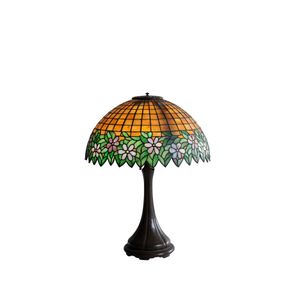Handel Art Nouveau Lamp with Orange Glass Shade
An Art Nouveau lead glass and bronze lamp, by Handel, circa 1910, the shade with an orange glass ground and a band of flowers, the naturalistic lobed bronze base signed 'Handel' to the mould, 62 cm high, 47 cm diameter
You must be a subscriber, and be logged in to view price and dealer details.
Subscribe Now to view actual auction price for this item
When you subscribe, you have the option of setting the currency in which to display prices to $Au, $US, $NZ or Stg.
This item has been sold, and the description, image and price are for reference purposes only.
- Lead Crystal - The first clear glass, called cristallo was invented during the 15th century in Venice. Prior to this the glass had a slight yellow or greenish colour as a result of iron ore impurities with the glass. 'Cristallo' was heavily exported .
In 1675, while attempting to counter the Venetian dominance of the glass market, British glassmaker George Ravenscroft invented lead glass, by adding lead oxide to to replace the calcium content in glass.
The new glass he created was quicker to melt, and stayed moulten longer, making it easier to work. More importantly, it had a higher refractive index, adding to its brilliance and beauty, especially when embellished with wheel cut decoration.
Lead crystal, is variety of lead glass, with a higher percentage of lead oxide than lead glass.
Ravenscroft's patent on lead crystal expired in 1681, and more glass makers were able to take advantage of his invention. The expansion in production resulted in England to overtaking Venice as the centre of the glass industry in the eighteenth and nineteenth centuries. - Circa - A Latin term meaning 'about', often used in the antique trade to give an approximate date for the piece, usually considered to be five years on either side of the circa year. Thus, circa 1900 means the piece was made about 1900, probably between 1895 and 1905. The expression is sometimes abbreviated to c.1900.
- Lead Glass - Lead glass, also known as lead crystal, is a type of glass that contains a high percentage of lead oxide. This gives lead glass a high refractive index, making it sparkle and giving it a distinct "crystal" appearance. Lead glass is often used to make high-end wine glasses, decanters, and other decorative objects. Lead crystal is prized for its clarity, brilliance, and weight, as well as its beautiful, intricate designs.
- Art Nouveau Period - The Art Nouveau period was a cultural movement that emerged in the late 19th century, and was characterized by its emphasis on natural forms, flowing lines, and a decorative, ornamental style. Art Nouveau was a reaction against the ornate and heavily stylized designs of the previous era, and sought to create a new, more organic aesthetic.
Art Nouveau was characterized by its use of sinuous, curving lines, as well as a focus on natural elements such as flowers, vines, and other organic shapes. Art Nouveau designers sought to create a total work of art, in which every element of a building or object was designed to be harmonious with the overall design.
Some of the most iconic examples of Art Nouveau design include the Paris Metro entrances designed by Hector Guimard, the works of the artist Alphonse Mucha, and the architecture of Victor Horta in Brussels.
The Art Nouveau period was at its peak between 1890 and 1910, but began to decline in popularity by the start of World War I. However, Art Nouveau remains an important influence on design and art to this day, and continues to be celebrated for its emphasis on natural forms and decorative style. - Bronze - An alloy of copper and tin, traditionally in the proportions of about 9 parts of copper to 1 part of tin.
The discovery of bronze in Western Asia in the 4th century enabled people to create metal objects which were superior to those previoulsy possible because of its strength and hardness, and it has been used throughout the world for weapons, coins, tools, statuary and other decorative items.
It is very fluid in a molten state, and its hardness, strength when set, and non-corrosive properties makes it most suitable for casting sculpture.
This item has been included into following indexes:
